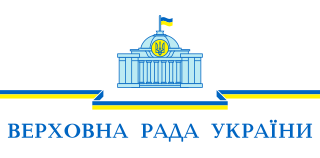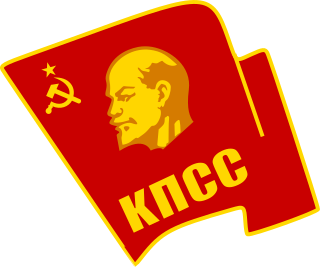
The Ukrainian Soviet Socialist Republic, also known as the Soviet Ukraine, was one of the constituent republics of the Soviet Union from the Union's inception in 1922 to its breakup in 1991. The republic was governed by the Communist Party of Ukraine as a unitary one-party socialist soviet republic.

The Latvian Soviet Socialist Republic, also known as Soviet Latvia or Latvia, was a republic of the Soviet Union.

The Popular Front of Latvia was a political organisation in Latvia in the late 1980s and early 1990s which led Latvia to its independence from the Soviet Union. It was similar to the Popular Front of Estonia and the Sąjūdis movement in Lithuania.

The Verkhovna Rada of Ukraine, often simply Verkhovna Rada or just Rada, is the unicameral parliament of Ukraine. The Verkhovna Rada is composed of 450 deputies, who are presided over by a chairman (speaker). The Verkhovna Rada meets in the Verkhovna Rada building in Ukraine's capital Kiev.

Mircea Ion Snegur was the first President of Moldova from 1990–1997. Before that, he served as Chairman of the Presidium of the Supreme Soviet 1989–1990 and Chairman of the Supreme Soviet from 27 April to 3 September 1990. In the Soviet era, he was often known in English as Mircha Ivanovich Snegur, a transliteration from the Russian Мирча Иванович Снегур.

The National Assembly, also transliterated as Milli Majlis, is the legislative branch of government in Azerbaijan. The unicameral National Assembly has 125 deputies: previously 100 members were elected for five-year terms in single-seat constituencies and 25 were members elected by proportional representation; as of the latest election, however, all 125 deputies are returned from single-member constituencies. Milli Majlis was the first secular republican parliament in the Muslim world.

The Act of the Re-Establishment of the State of Lithuania or Act of March 11 was an independence declaration by the Lithuanian Soviet Socialist Republic adopted on March 11, 1990, signed by all members of the Supreme Council of the Republic of Lithuania led by Sąjūdis. The act emphasized restoration and legal continuity of the interwar-period Lithuania, which was occupied by the USSR and lost independence in June 1940. It was the first time that an occupied state declared independence from the dissolving Soviet Union.
The Congress of Estonia was an innovative grassroots parliament established in Estonia as a part of the process of regaining of independence from the Soviet Union. It also challenged the power and authority of the pre-existing quasi-parliament in the country, called the Supreme Soviet of the Estonian SSR, which had been imposed on Estonia after Moscow's illegal annexation in 1940. The Congress of Estonia declared that it represented the highest authority on questions of Estonian statehood and citizenship, deriving this authority from the consent and initiative of the citizens of Estonia. The aim of the Congress was to restore Estonian independence based on the principle of legal continuity, with the pre-1940 republic of Estonia, which had been established in 1918, as the foundation.

The Declaration "On the Restoration of Independence of the Republic of Latvia" was adopted on 4 May 1990, by the Supreme Soviet of the Latvian SSR. The Declaration stated that, although Latvia had de facto lost its independence in 1940, when it was annexed by the Soviet Union, the country had de jure remained a sovereign country as the annexation had been unconstitutional and against the will of the people of Latvia. Therefore it resolved that the Molotov–Ribbentrop Pact and the Soviet occupation of Latvia in 1940 were illegal, and annulled the declaration on the accession of Latvia to the Soviet Union of 21 July 1940, re-instituted the Constitution of Latvia of 1922, which was thereupon partly suspended, and set a period of transition to de facto independence, which would end upon the first session of Saeima. It also ruled that during the transitional period the Constitution of the Latvian SSR and other laws would remain applicable as long as they did not contradict articles 1, 2, 3, and 6 of the Constitution of Latvia, which were reinforced by the declaration. It was provided that a committee to elaborate a new edition of the Constitution of Latvia should be created. Social, economic, cultural, and political rights were granted to citizens and residents of Latvia in accordance with international human rights. The declaration also stated that Latvia would form its relationship with the Soviet Union on the basis of the Latvian–Soviet Peace Treaty of 1920, in which the Soviet Union had recognized the independence of Latvia as inviolable "for all future time". The 4th of May is a national holiday in Latvia.

The Supreme Soviet of the Lithuanian SSR was the supreme soviet of the Lithuanian SSR, one of the republics comprising the Soviet Union. The Supreme Soviet was established in August 1940 when the People's Seimas declared itself the provisional Supreme Soviet. According to the constitution it was very similar to modern democratic parliaments: it was elected every four years and had the power to create, amend and ratify the constitution, laws, and treaties and appoint officials in the Council of Ministers. However, in reality the elections were staged, the Soviet had very little actual power and carried out orders given by the Communist Party of Lithuania (CPL). The situation changed in 1988, when the Lithuanians began seeking independence from the Soviet Union. The political power shifted from CPL to the Soviet, which adopted a number of important constitutional amendments and laws, paving the way for the independence. The first free elections were held in February 1990 and were won by pro-independence Sąjūdis. During its first session the Supreme Soviet adopted the Act of the Re-Establishment of the State of Lithuania and renamed itself the Supreme Council of the Republic of Lithuania.
The first relatively free election to the Supreme Soviet (Rada) held in the Ukrainian Soviet Socialist Republic took place in several stages, from March 4 to March 18, 1990. The elections were held to elect deputies to the republic's parliament, the Verkhovna Rada. Simultaneously, elections of local provincial ("oblast'") councils also took place in their respective administrative divisions.

Parliamentary elections were held in the Latvian SSR on 18 March 1990. It was the first free parliamentary election in Latvia since 1931 and saw 201 deputies elected to the Supreme Soviet of the Latvian SSR, 170 of them in the first round. Run-off elections were held on 25 March, 1 April and 29 April. The Popular Front of Latvia won over two-thirds of the vote. Unlike its Estonian and Lithuanian counterparts, the Latvian Communist Party did not separate from the Communist Party of the Soviet Union. Nonetheless, on 3 May 1990, the new Supreme Soviet re-elected the Communist Party member Anatolijs Gorbunovs as its chairman, effectively the leader of Latvia. He subsequently resigned from the party, and a year later the Communist Party was banned by the parliament.
The Lithuanian legislative elections for 141 seats in the Supreme Soviet of the Lithuanian SSR were held in the Lithuanian SSR on 24 February with run-off elections on 4, 7, 8 and 10 March 1990. In six constituencies voter turnout was below required minimum, therefore a third round was held on April 7 and 21. For the first time since the election to the People's Seimas in 1940, non-communist candidates were allowed to run. It was the first and the only free multi-party elections in Soviet Lithuania. Pro-independence Sąjūdis movement refused to become a political party and endorsed candidates of various other political parties based on their personal merits. These endorsements often meant more than official party affiliations, and Sąjūdis-backed candidates won 91 out of 135 seats. During its third session on 11 March 1990, the Supreme Soviet of the Lithuanian SSR adopted the Act of the Re-Establishment of the State of Lithuania thus declaring Lithuania's independence from the Soviet Union.
The term People's Parliaments or People's Assemblies was used in 1940 for puppet legislatures put together after show elections in Estonia, Latvia, and Lithuania to legitimize the occupation by the Soviet Union. In all three countries, the elections to the parliaments followed the same scenario, dictated by functionaries in Moscow and borrowed from incorporation of Belarusian and Ukrainian lands in the aftermath of the invasion of Poland in 1939.

An election for a Supreme Soviet took place in Moldavia in 1940. The poll was an effort to legitimize the Soviet occupation of Bessarabia and Northern Bukovina which had taken place immediately prior. Since 1918 these regions had been part of Romania. All deputies returned were members of the Communist Party of Moldavia, a branch of the Communist Party of the Soviet Union. The Supreme Soviet subsequently adopted the 1941 Constitution of the Moldavian Soviet Socialist Republic, under which the MSSR was a constituent of the Soviet Union. Soviet control was interrupted by the Axis occupation from 1941 to 1944.

Parliamentary elections were held in Lithuania in two stages on 25 October and 15 November 1992. All 141 members of the Seimas, which replaced the Supreme Council, were elected; 70 based on proportional party lists and 71 in single member constituencies. Where no candidate gained more than 50% of the vote on 25 October, a run-off was held on 15 November. The first round of the elections were held simultaneously with a referendum on the adoption of a new constitution.

The Estonian Soviet Socialist Republic, also known as Soviet Estonia or Estonia was an unrecognized republic of the Soviet Union, administered by a subordinate of the Soviet government. The ESSR was initially established on the territory of the Republic of Estonia on 21 July 1940, following the invasion of Soviet troops on 17 June 1940, and the installation of a puppet government backed by the Soviet Union, which declared Estonia a Soviet constituency. The Estonian SSR was subsequently incorporated into the Soviet state on 9 August 1940. The territory was occupied by Nazi Germany from 1941 to 1944 and administered as a part of Reichskommissariat Ostland.
Parliamentary elections were held in Estonia on 14 and 15 July 1940 alongside simultaneous elections in Latvia and Lithuania. The elections followed the Soviet occupation of the three countries, and were rigged. The Estonian Working People's Union, a Communist front group, was the only party allowed to run, and won all 80 seats with 92.8% of the vote. The newly elected People's Parliament declared the Estonian SSR on 21 July and requested admission to the Soviet Union the following day. The request was approved by the Soviet government on 6 August.

The dissolution of the Soviet Union occurred on 26 December 1991, officially granting self-governing independence to the Republics of the Union of Soviet Socialist Republics (USSR). It was a result of the declaration number 142-Н of the Supreme Soviet of the Soviet Union. The declaration acknowledged the independence of the former Soviet republics and created the Commonwealth of Independent States (CIS), although five of the signatories ratified it much later or did not do so at all. On the previous day, 25 December, Soviet President Mikhail Gorbachev, the eighth and final leader of the USSR, resigned, declared his office extinct and handed over its powers—including control of the Soviet nuclear missile launching codes—to Russian President Boris Yeltsin. That evening at 7:32 p.m., the Soviet flag was lowered from the Kremlin for the last time and replaced with the pre-revolutionary Russian flag.

Independence Day is a national holiday in Estonia marking the anniversary of the Estonian Declaration of Independence in 1918. It is commonly celebrated with fireworks, concerts, parades, and parties. It is the national day of Estonia.
















